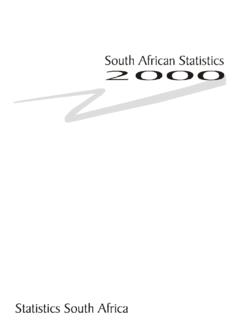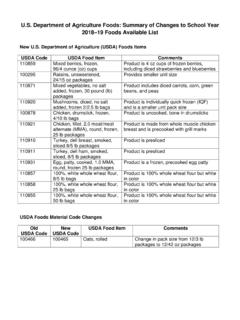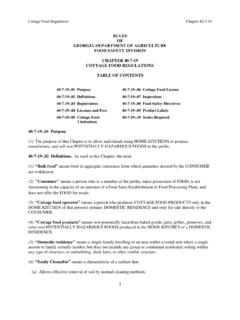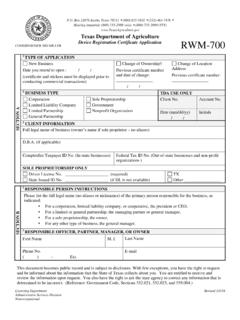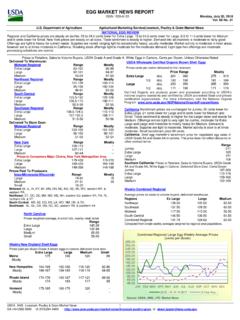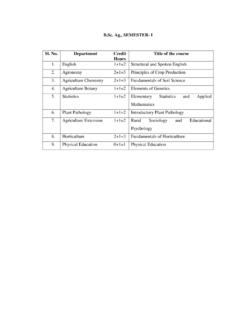Transcription of Statistics South Africa National Department of …
1 Statistics South Africa National Department of agriculture Private Bag X44 Private Bag X250 Pretoria 0001 Pretoria 0001 South Africa South Africa 274 Schoeman Street 30 Hamilton Street Pretoria Arcadia, Pretoria Author: Joyce Lestrada-Jefferis Analysis and Statistical Consulting Statistics South Africa Stats SA contact details: Users enquiries: (012) 310-8600 Fax: (012) 310-8500 Main switchboard: (012) 310-8911 Fax: (012) 322-3374 E-mail: Website: National Department of agriculture contact details: Main switchboard: (012) 319-6000 Fax: (012) 323-8345 E-mail: Website: Employment trends in agriculture in South Africa Statistics South Africa and National Department of agriculture 2000 Dr FM Orkin Head Stats SA Mrs B Njobe Director-general National Department of agriculture Published by Statistics South Africa Private Bag X44 Pretoria 0001 ISBN 0-621-30007-1 Copyright, 2000.
2 This publication, including the data on which it is based, is copyright. Apart from uses permitted under the Copyright Act of 1978, no part of it may be reproduced or copied in any format or by any process, and no copy or reproduction may be sold, without prior permission or licence from Statistics South Africa . Statistics South Africa Library Cataloguing-in-Publication (CIP) Data Employment trends in agriculture in South Africa / Statistics South Africa and National Department of agriculture . Pretoria : Statistics South Africa , 2000 xv, 122 p ISBN 0-621-30007-1 1. agriculture - South Africa . 2. agriculture - Economic aspects 3. Agricultural laborers. 4. Agricultural wages. 5. Agricultural systems. I. Statistics South Africa . II. South Africa . National Department of agriculture . LCSH-16 A complete set of Stats SA publications is available at the Stats SA library and the following public libraries: National Library of South Africa , Pretoria Library of Parliament, Cape Town National Library of South Africa (Cape Town Division), Cape Town Bloemfontein Public Library Natal Society Library, Pietermaritzburg Johannesburg Public Library Foreword Employment trends in agriculture is the outcome of a unique collaboration between Statistics South Africa (Stats SA) and the National Department of agriculture (NDA).
3 The agricultural sector plays an important role in South Africa s economy. It offers both employment and opportunities for sustaining livelihoods, and there are strong upstream and downstream linkages between the sector and the rest of the economy. agriculture enhances foreign exchange reserves, provides raw materials for the industrial sector, and is a market for goods and services from other sectors. Within the rural areas of South Africa s former homelands, 52% of employed people work on farms. Stats SA wrote a first draft of this report in preparation for the Agricultural Indaba on Job Creation, held in October 1999. Thereafter, the draft was comprehensively revised and data from the NDA incorporated into the report. Co-operation between the two departments has resulted in a more-comprehensive use of different datasets to provide an overview of aspects of the agricultural sector in general, focusing specifically on employment and livelihoods in agriculture .
4 The datasets considered were derived from four surveys: the 1996 population census, which covered households throughout South Africa ; the annual commercial agricultural surveys of 1988-1996; the 1997 rural survey, which focused exclusively on subsistence farming in what were previously designated as homeland areas; and a case study conducted by the NDA in 1999, based on a sample of commercial farmers. Data from each survey enabled analysis of different elements of employment and livelihoods in the sector. Variability in the date of data collection and type of instruments used made direct comparisons between each dataset difficult. However, the relative strength of each instrument used to compile the report has facilitated a comprehensive overview. Despite the importance of agriculture , the structure of the sector and its elements has been under-researched. As a result, policy makers have often been confronted with data inadequate for the requirements of addressing the historical imbalances and inadequacies created, inter alia, by the effects of past policies within the sector.
5 With this deficiency in mind, the NDA approached Stats SA to integrate information across different surveys in relation to employment in agriculture . Co-operation between two departments to address these inadequacies in data and analysis is indeed an exciting development. Collaboration and co-ordination between different institutions and structures of government is a crucial element in all attempts to address the legacies on the past, and restructure society on a more-equitable, inclusive and democratic basis. Dr FM Orkin Ms B Njobe Head Director-General Statistics South Africa National Department of agriculture Contents Page Summary of findings The overall labour market ii Size of the agricultural sector iii Employment iii Age and education iv Status and type of employment vi The National Department of agriculture (NDA) case study vii Occupations ix Income/remuneration ix Sales, expenditure and debt xi Subsistence farming xiii Comparison with other sectors of the economy xiv Chapter 1: Aim and methodology Background 1 Aim of this report 1 Data sources 2 Methodological issues 2 Technical notes 4 Layout of the report 4 Chapter 2.
6 Labour market patterns Introduction 7 The new official definition of unemployment 7 The working-age population 8 Labour force participation 9 Patterns of unemployment 10 Labour absorption 11 Unemployment and level of education 12 Assessing the differences in labour market variables 13 Household incomes in the former homelands 15 Summary 18 Chapter 3: Size of farms and biographical characteristics of agricultural workers Introduction 19 Employment in agriculture 19 Size of farming units 22 The age profile of people engaged in agriculture by sector 24 The age profile by population group 26 Level of education 26 Summary 29 Chapter 4: Status in employment in the agricultural sector Introduction 31 Status of employment by population group and province 31 Regular and casual work 32 Summary 34 Case study: Recent trends in employment in the agricultural sector by the National Department of agriculture 34 The questionnaire 34 Issues covered by the case study 35 Methodology 35 Results 35 Summary 38 Chapter 5: Type of employment in agriculture Introduction 39 Type of employment by population group and province 39 Type of employment in the former homelands 40 Summary 43 Chapter 6: Occupation of people in agriculture Introduction 45 Occupations in agriculture and hunting 45 Occupations in the former homelands 46 Domestic workers 49 Summary 50 Chapter 7: Income and remuneration in agriculture Introduction 51 Individual incomes by population group and province 51 Remuneration in the commercial farming sector 53 Household incomes in the former homelands 57 Summary 60 Chapter 8: Sales, expenditure and debt in agriculture Introduction 61 Income from sales: commercial farms 62 Income from sales: former homelands 64 Expenditure: commercial farms 68 Expenditure.
7 Former homelands 70 Farming debt 71 Summary 74 Chapter 9: Subsistence farming in the former homelands Introduction 75 Size of the subsistence farming sector 76 Age profile of subsistence farmers 77 Level of education attainment of subsistence farmers 78 Type of employment of subsistence farmers 79 Household income of subsistence farmers 81 Summary 83 Chapter 10: Comparison of the agriculture sector with other sectors of the economy Introduction 85 Age profiles in the major economic sectors 85 Educational attainment in the major economic sectors 86 Employment status in the major economic sectors 88 Type of employment in the major economic sectors 89 Occupations in the major economic sectors 90 Income distribution in the major economic sectors 92 Summary 93 Appendix 1: Definitions and key concepts 95 Appendix 2: Statistical tables 97 Selected references 122 Figures Page Summary of findings Figure i: Size of arable land under cultivation or fallow land among households engaged in crop farming in the former homelands, June 1997 iii Figure ii: Age profile of those employed in the agriculture and hunting sub-sector by population group, October 1996 v Figure iii: Part-time employment in the agriculture and hunting sub-sector by province and gender, October 1996 vi Figure iv: Regular and casual employment in the commercial farming sector, 1988-1996 vii Figure v: Type of employment in the former homelands by broad employment category, June 1997 viii Figure vi: Average monthly remuneration of regular employees in the commercial farming sector, 1994-1996 x Figure vii: Source of income from sales in the commercial farming sector by type of product, 1988-1996 xi Figure viii: Annual income from the sale of products in the former homelands, by type of product, June 1997 xii Figure ix.
8 Percentage distribution of subsistence farmers in the former homelands by gender and province, June 1997 xiii Figure x: Distribution of income in the agricultural sector compared with all other sectors combined, October 1996 xv Chapter 2: Labour market patterns Figure 1: The labour market in South Africa , October 1996 8 Figure 2: The labour market in the former homelands, June 1997 9 Figure 3: Unemployment rates by province and gender, October 1996 10 Figure 4: Unemployment rates in the former homelands, June 1997 11 Figure 5: Unemployment rates by level of education and gender, October 1996 12 Figure 6: Unemployment rates by level of education in the former homelands, June 1997 13 Figure 7: Differences in unemployment rates between tribal areas in the 1996 population census and the 1997 rural survey 14 Figure 8: Principal source of income of households in which employed people live compared with households which have no employed persons, June 1997 15 Figure 9: Distribution of household income in households with employed people compared with households without employed people, June 1997 16 Figure 10: Distribution of income of households with and without employed members, June 1997 17 Figure 11: The distribution of households in which employed people live by province, June 1997 18 Chapter 3: Size of farms and biographical characteristics of agricultural workers Figure 12: The structure of the agricultural sector, October 1996 20 Figure 13: Pattern of employment in rural areas of the former homelands by province, June 1997 21 Figure 14: Comparison of the provincial pattern of employment in commercial farming from the enterprise survey in 1996 with farms in the former homeland areas, June 1997 22 Figure 15.
9 Average size of farming units in the commercial sector, 1988-1996 23 Figure 16: Size of arable land under cultivation or lying fallow among households engaged in crop farming in the former homelands, June 1997 23 Figure 17: Age profile of employed people (15-65 years) 24 Figure 18: Age-sex profile of those employed in the former homelands, June 1997 25 Figure 19: Age profile of those employed in the agriculture and hunting sub-sector by population group, October 1996 26 Figure 20: Level of educational attainment among those employed in the agriculture and hunting sub-sector by population group, October 1996 27 Figure 21: Proportion of employed people without schooling in the agriculture and hunting sub-sector in each province, October 1996 27 Figure 22: Pattern of educational attainment among employed people in the former homelands, June 1997 28 Figure 23: Proportion of people employed on farms in the former homelands with no education, June 1997 29 Chapter 4: Status in employment in the agricultural sector Figure 24: Full-time and part-time employment of people in the agriculture and hunting sub-sector by population group and gender, October 1996 31 Figure 25: Part-time employment in the agriculture and hunting sub-sector by province and gender, October 1996 32 Figure 26: Regular and casual work in the commercial farming sector, 1988-1996 33 Figure 27: Regular and casual employment on commercial farms by province, 1996 33 Case study: Recent trends in employment in the agricultural sector by the National Department of agriculture Figure A: Percentage change in the number of workers employed on a sample of commercial farms, 1994/95-1998/99 36 Figure B.
10 Percentage change in employment of different categories of workers employed by commercial farmers by type of farming activity, 1994/95-1998/99 37 Figure C: Percentage of skilled and unskilled workers employed by commercial farmers, 1994/95-1998/99 38 Chapter 5: Type of employment in agriculture Figure 28: Type of employment in the agriculture and hunting sub-sector by population group, October 1996 39 Figure 29: Type of employment in the agriculture and hunting sub-sector by province, October 1996 40 Figure 30: Type of employment in the former homelands by broad employment category, June 1997 41 Figure 31: Type of employment among farm workers in the former homelands by province, June 1997 41 Figure 32: Type of employment among informal sector workers in the former homelands by province, June 1997 42 Figure 33: Type of employment among formal sector workers in the former homelands by province, June 1997 43 Chapter 6: Occupation of people in agriculture Figure 34: Occupations in the agriculture and hunting sub-sector by population group, October 1996 45 Figure 35: Occupations in the agriculture and hunting sub-sector by gender, October 1996 46 Figure 36: Occupation status of people doing farm work in the former homelands, June 1997 47 Figure 37: Occupation status of informal sector workers in the former homelands, June 1997 48 Figure 38: Occupation status of formal sector workers in the former homelands, June 1997 49 Chapter 7: Income and remuneration in agriculture Figure 39: Monthly income of people employed in the agriculture and hunting sub-sector by population group, October 1996 52 Figure 40: Monthly incom
